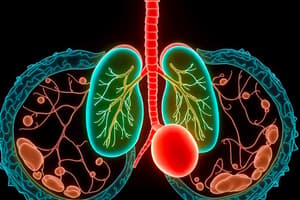Podcast
Questions and Answers
What is the first step in the process of nutrition in organisms?
What is the first step in the process of nutrition in organisms?
- Fermentation of ethanol in mitochondria
- Use of oxygen to produce carbon dioxide
- Break-down of glucose into pyruvate (correct)
- Conversion of pyruvate to glucose
In which part of the cell does the break-down of glucose into pyruvate occur?
In which part of the cell does the break-down of glucose into pyruvate occur?
- Nucleus
- Cell membrane
- Cytoplasm (correct)
- Mitochondria
What type of respiration occurs in yeast during the fermentation process?
What type of respiration occurs in yeast during the fermentation process?
- Anaerobic respiration (correct)
- Cellular respiration
- Aerobic respiration
- Oxidative phosphorylation
What are the end products of pyruvate breakdown during fermentation in yeast?
What are the end products of pyruvate breakdown during fermentation in yeast?
Where does the further breakdown of pyruvate using oxygen occur?
Where does the further breakdown of pyruvate using oxygen occur?
What is the primary role of glucose in the process of nutrition?
What is the primary role of glucose in the process of nutrition?
Which molecule is produced from the breakdown of glucose before any further reactions?
Which molecule is produced from the breakdown of glucose before any further reactions?
What distinguishes anaerobic respiration from aerobic respiration?
What distinguishes anaerobic respiration from aerobic respiration?
In which part of the cell does anaerobic respiration primarily occur?
In which part of the cell does anaerobic respiration primarily occur?
Which of the following best describes the conversion of pyruvate during fermentation?
Which of the following best describes the conversion of pyruvate during fermentation?
Flashcards
Glycolysis
Glycolysis
The process of breaking down glucose into pyruvate, a three-carbon molecule, which occurs in the cytoplasm of cells.
Anaerobic Respiration
Anaerobic Respiration
A type of cellular respiration that occurs without the presence of oxygen. It breaks down pyruvate into ethanol and carbon dioxide, and is commonly used by yeast during fermentation.
Pyruvate
Pyruvate
A three-carbon molecule that is produced during glycolysis and serves as a key intermediate in cellular respiration.
Mitochondria
Mitochondria
Signup and view all the flashcards
Aerobic Respiration
Aerobic Respiration
Signup and view all the flashcards
What is the first step in cellular respiration?
What is the first step in cellular respiration?
Signup and view all the flashcards
What is anaerobic respiration?
What is anaerobic respiration?
Signup and view all the flashcards
What is aerobic respiration?
What is aerobic respiration?
Signup and view all the flashcards
Where does aerobic respiration take place?
Where does aerobic respiration take place?
Signup and view all the flashcards
What's pyruvate?
What's pyruvate?
Signup and view all the flashcards
Study Notes
Nutrition and Energy Production
- Organisms use food for energy in various life processes
- Organisms use different methods to break down food for energy, some using oxygen and others not
- Some organisms use oxygen to break down glucose completely into carbon dioxide and water
- Some organisms use pathways that do not require oxygen
- The first step in all these processes involves breaking down glucose (a six-carbon molecule) into pyruvate (a three-carbon molecule) in the cytoplasm
- Pyruvate can be further converted into ethanol and carbon dioxide in yeast during fermentation, an anaerobic process (occurs without oxygen)
- Fermentation is an anaerobic (oxygen-absent) process
- Pyruvate breakdown using oxygen occurs in the mitochondria
Studying That Suits You
Use AI to generate personalized quizzes and flashcards to suit your learning preferences.




